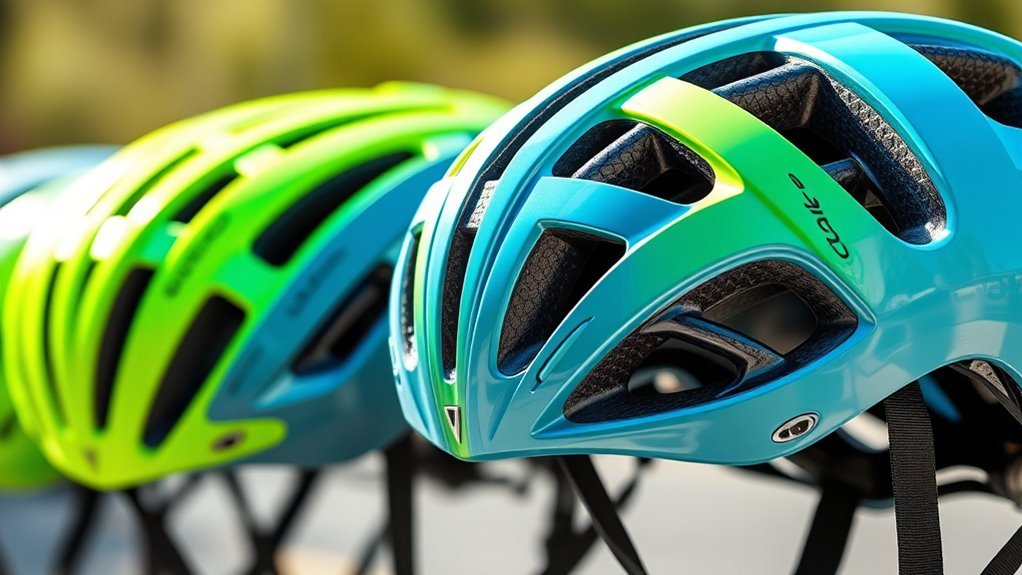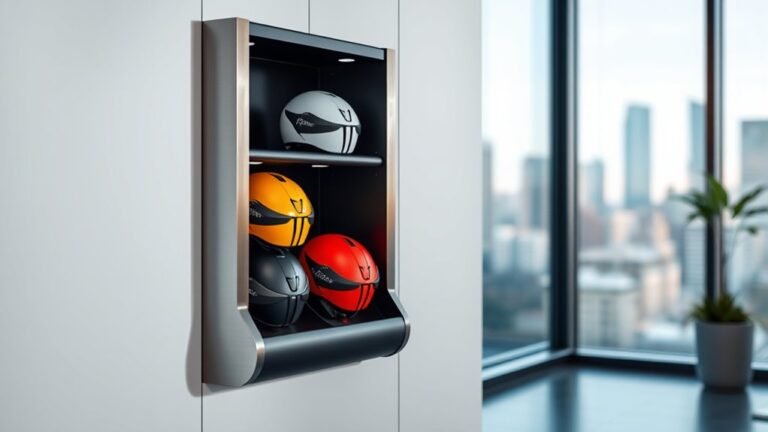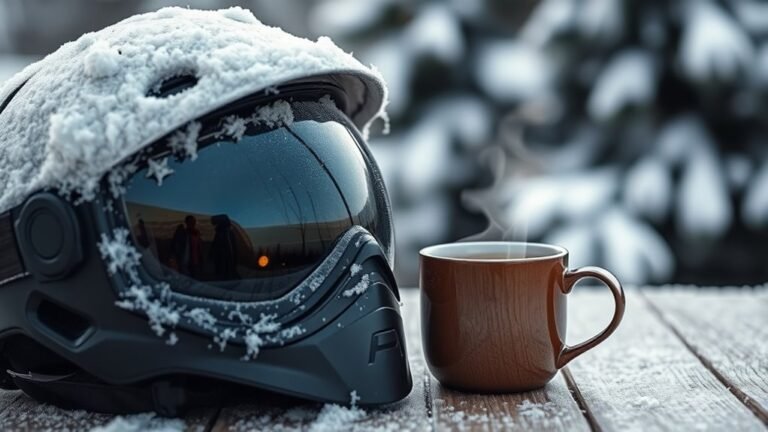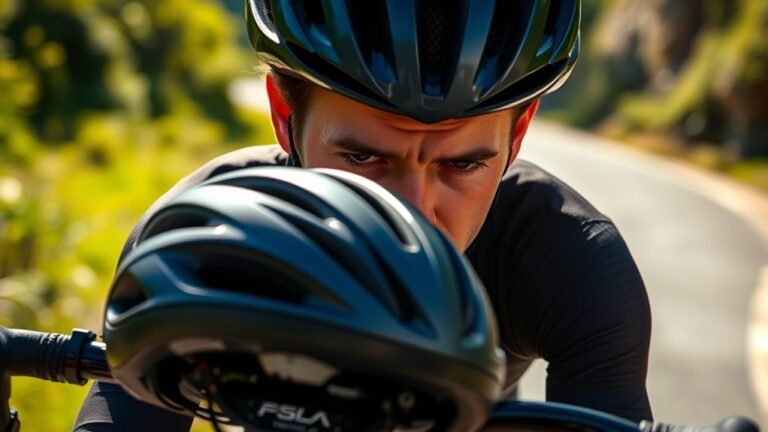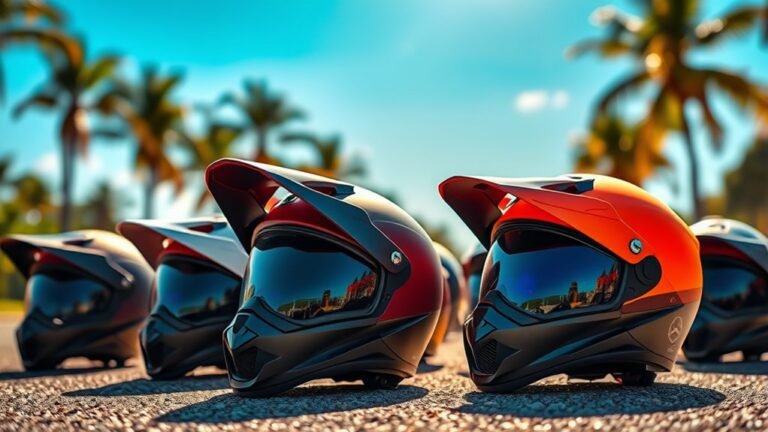Best Bicycle Helmets for Triathlons
When selecting the best bicycle helmets for triathlons, you should prioritize aerodynamic designs, lightweight materials, and effective ventilation. Helmets like the Giro Aerohead and Specialized S-Works Evade excel in reducing drag while ensuring comfort. For long-distance rides, consider models with multiple airflow channels. Budget options, such as those from Bell and Giro, also meet safety standards without breaking the bank. Opting for certified helmets guarantees protection. There’s more to explore about features and maintenance that can enhance your ride experience.
Importance of Choosing the Right Helmet

When it comes to triathlons, selecting the right helmet isn’t just a matter of personal preference; it can greatly impact your performance and safety. The choice of helmet styles, such as aero or ventilated designs, plays an essential role in how you cut through the wind and maintain comfort during long rides. Aero helmets offer reduced drag but may sacrifice ventilation, while ventilated options provide airflow at the cost of some aerodynamic efficiency. Additionally, helmet materials can influence weight and durability. Lightweight materials like polycarbonate enhance comfort, while advanced composites can offer superior protection. Ultimately, understanding these differences empowers you to make informed decisions that align with your performance goals and safety needs, giving you the freedom to compete at your best.
Key Features to Look For in a Triathlon Helmet
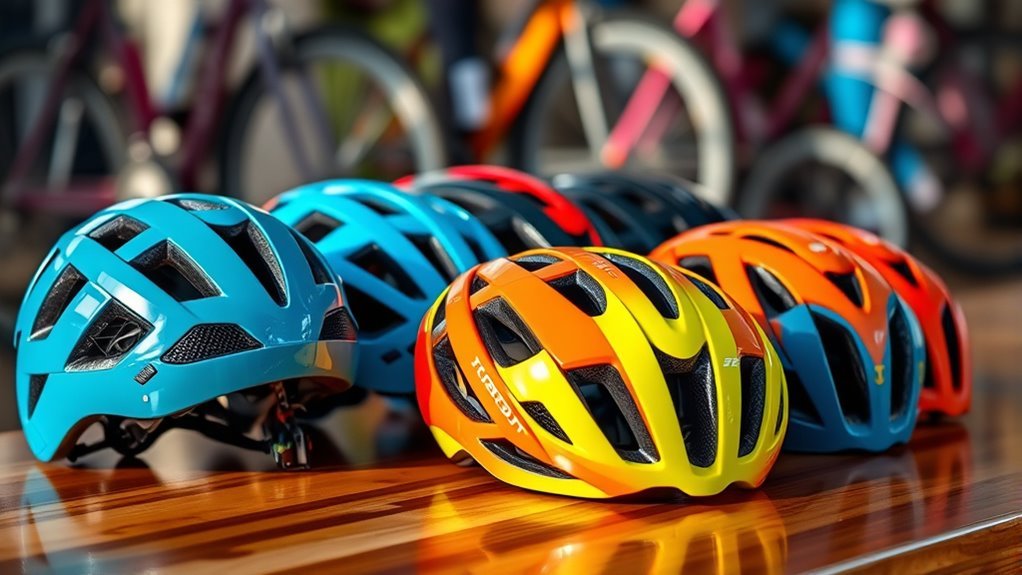
When selecting a triathlon helmet, you’ll want to prioritize features that enhance your performance. An aerodynamic design can markedly reduce drag, while lightweight materials guarantee you won’t feel weighed down during the race. Additionally, effective ventilation is essential for maintaining comfort, especially in longer events.
Aerodynamic Design Benefits
Although you might prioritize comfort and fit when selecting a triathlon helmet, the aerodynamic design is crucial for enhancing your performance. A helmet with a streamlined shape minimizes wind resistance, allowing you to cut through the air more efficiently and maintain higher speeds.
Consider these key features:
- Smooth surface: Reduces turbulence for better airflow.
- Rear spoiler: Helps stabilize airflow as you ride.
- Ventilation: Strategically placed to balance aerodynamics and cooling.
- Chin strap design: Guarantees a secure fit without adding drag.
- Low-profile construction: Contributes to a sleek, fast appearance.
Investing in an aerodynamic helmet means you’ll experience less drag, ultimately allowing you to reach your goals with greater freedom and speed.
Lightweight Materials Importance
Choosing a triathlon helmet made from lightweight materials is essential for optimizing your performance. Lightweight advantages include reduced fatigue and enhanced speed, allowing you to focus solely on your race. When evaluating material types, look for options like polycarbonate and carbon fiber, which offer strength without unnecessary weight. These materials provide durability while minimizing drag, vital for maintaining momentum. Additionally, a lighter helmet can improve your comfort, reducing the burden during long distances. The right choice in materials not only influences your overall speed but also impacts your energy management. By prioritizing lightweight designs, you empower yourself to achieve your personal best, ensuring you experience the freedom and exhilaration that comes with triathlon racing.
Ventilation and Comfort
Lightweight materials play a significant role in a triathlon helmet’s overall design, but ventilation and comfort are equally important features that can greatly influence your performance. A well-ventilated helmet helps with heat management, ensuring you stay cool during intense rides. Effective moisture control prevents sweat from distracting you, allowing for a more focused experience.
When evaluating helmets, consider these key features:
- Multiple air vents for airflow
- Moisture-wicking padding for comfort
- Adjustable retention systems for a secure fit
- Lightweight construction to reduce fatigue
- Aerodynamic design to minimize drag
Prioritizing these aspects will not only enhance your comfort but will also optimize your performance, letting you fully embrace the freedom of the ride.
Top Picks for Aerodynamic Helmets
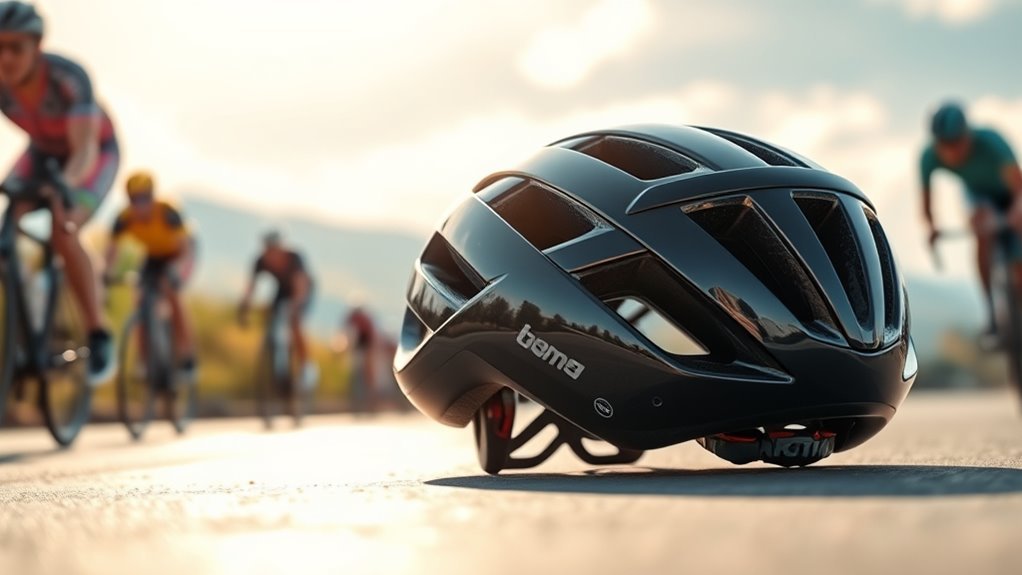
When it comes to triathlons, selecting the right aerodynamic helmet can greatly impact your performance. The top picks often undergo extensive aero testing in wind tunnels to guarantee they minimize drag and maximize speed. Look for models with sleek designs that reduce turbulence, effectively streamlining your ride. Helmets like the Giro Aerohead and the Specialized S-Works Evade are renowned for their efficiency and comfort, providing a balance between aerodynamics and fit. These helmets not only enhance speed but also offer features like adjustable visors and lightweight materials. When you’re racing against the clock, every second counts, and investing in a high-performing aerodynamic helmet can make all the difference in achieving your best time.
Best Ventilated Helmets for Long-Distance Rides
While aerodynamic helmets are essential for maximizing speed in triathlons, comfort and ventilation become paramount during long-distance rides. The best ventilated helmets offer cutting-edge cooling technology and are crafted from the best materials, ensuring you stay cool and comfortable as you tackle miles. Here’s what to look for:
Aerodynamic helmets boost speed, but for long rides, comfort and ventilation are essential for an enjoyable experience.
- Multiple airflow channels for superior ventilation
- Lightweight construction that doesn’t compromise safety
- Moisture-wicking padding to keep sweat at bay
- Adjustable straps for a personalized fit
- Reinforced mesh for added breathability
Investing in a well-ventilated helmet not only enhances your riding experience but also supports your endurance, allowing you to focus on the freedom of the open road without the distraction of overheating.
Budget-Friendly Options for Triathletes
When you’re looking for budget-friendly helmet options as a triathlete, it’s vital to focus on affordable brands that still meet safety standards. You’ll want to take into account essential features like ventilation, weight, and fit to guarantee both comfort and performance during your races. Understanding these aspects can help you make an informed decision without compromising safety or breaking the bank.
Affordable Helmet Brands
Although investing in a high-quality bicycle helmet is essential for safety during triathlons, it doesn’t have to break the bank. There are several affordable options that can meet your needs without sacrificing quality. Here are some budget brands worth considering:
- Bell: Known for their reliable safety features and comfort.
- Giro: Offers lightweight designs with great ventilation.
- Specialized: Combines performance and affordability effectively.
- Kask: Provides aerodynamic options that won’t empty your wallet.
- Lazer: Features customizable fit systems and solid protection.
These brands offer budget-friendly helmets that guarantee you stay safe and stylish as you race. By choosing one of these affordable options, you can focus on achieving your triathlon goals without worrying about your budget.
Essential Features to Consider
Choosing an affordable helmet doesn’t mean you have to compromise on safety and performance. When selecting a budget-friendly option, consider the latest helmet technology and design innovations that enhance both aerodynamics and comfort. Look for lightweight materials that provide ventilation without sacrificing protection. Many affordable helmets now incorporate advanced foam systems, which absorb impact while keeping weight down. Additionally, adjustable fit systems guarantee a secure, personalized fit, vital for long rides. Pay attention to the visor features as well; a well-designed visor can reduce glare without adding excess weight. By focusing on these essential features, you can find a helmet that offers both value and reliability, empowering you to tackle your triathlon goals confidently.
Safety Standards Compliance
Safety is paramount in any triathlon, and ensuring your helmet meets safety standards is essential, even on a budget. You’ll want to choose a helmet that complies with safety regulations and has undergone rigorous helmet testing. Here are some budget-friendly options that don’t compromise on safety:
- Lightweight materials for comfort during long rides
- Adjustable straps for a secure fit
- Ventilation systems to keep you cool
- Reflective elements for increased visibility
- Certifications from recognized safety organizations
Investing in a helmet that adheres to these standards allows you to focus on your performance while knowing you’re protected. Remember, a budget-friendly option can still offer the safety and reliability you need on race day.
Safety Certifications and Standards
When it comes to selecting a bicycle helmet for triathlons, understanding safety certifications and standards is essential for ensuring protection during your ride. Different regions have specific safety regulations that helmets must meet, such as the CPSC in the U.S. and the EN 1078 in Europe. These certifications indicate that a helmet has undergone rigorous testing through established certification processes to assess its impact resistance, retention system, and overall performance. Choosing a helmet bearing these certifications guarantees you’re investing in reliable protection. Additionally, look for certifications from organizations like Snell or ASTM for added assurance. By prioritizing safety standards, you’re not just enhancing your freedom on the road; you’re also making a responsible choice for your well-being.
Maintenance Tips for Your Bicycle Helmet
Proper maintenance of your bicycle helmet is essential for ensuring its longevity and effectiveness. Regular helmet cleaning and proper storage can greatly enhance your helmet’s durability. Follow these tips for ideal care:
Maintaining your bicycle helmet is key to its longevity and safety; regular cleaning and proper storage make all the difference.
- Wipe down the exterior with a damp cloth to remove dirt and grime.
- Use mild soap and water for a thorough cleaning of the inner padding.
- Inspect straps and buckles for wear and tear, replacing them if necessary.
- Store in a cool, dry place, away from direct sunlight, to prevent degradation.
- Avoid dropping or hitting your helmet against hard surfaces, as this can compromise safety.
Frequently Asked Questions
How Should I Properly Fit My Triathlon Helmet?
To properly fit your triathlon helmet, start by ensuring it sits level on your head, about two fingers above your eyebrows. Adjust the straps for a snug fit, allowing just enough room to fit a finger between your chin and the buckle. Make fit adjustments as needed to eliminate any movement. A well-fitted helmet enhances safety, providing maximum protection while allowing you the freedom to focus on your performance.
Can I Use a Regular Bike Helmet for Triathlons?
Yes, you can use a regular bike helmet for triathlons, but it’s crucial to take into account safety standards and comfort features. Many standard helmets meet safety requirements, but triathlon-specific models often provide enhanced ventilation and aerodynamic designs. If you value comfort during long rides, a triathlon helmet might offer better fit and less drag. Ultimately, while a regular helmet can suffice, choosing one built for your needs will enhance your performance and experience.
What Is the Lifespan of a Triathlon Helmet?
A triathlon helmet typically lasts about three to five years, depending on factors like usage and storage conditions. Ever wondered how helmet durability affects your safety? Signs it’s time for a replacement include visible damage, cracks, or if it’s been involved in an accident. Regularly check for these indicators to guarantee your helmet’s protection remains intact. When in doubt, prioritizing your safety with a new helmet is always a wise choice.
How Do I Clean My Triathlon Helmet?
To clean your triathlon helmet, start by using a damp cloth to wipe the exterior and remove dirt or sweat. For deeper cleaning, mix mild soap with water and gently scrub the interior padding and straps. Rinse thoroughly and let it air dry completely. Regular helmet maintenance is essential; avoid using harsh chemicals that could damage the materials. Following these cleaning tips guarantees your helmet remains in peak condition for your next race.
Are There Specific Helmets for Different Weather Conditions?
Absolutely, there are helmets tailored for various weather conditions. In sweltering heat, look for designs with excellent ventilation, allowing air to flow like a gentle breeze. Conversely, for cooler climates, helmets with insulation can shield your head from biting winds. Weather considerations play an essential role in your choice, as a well-ventilated helmet can keep you cool and safe, ensuring you enjoy the freedom of the ride, regardless of the forecast.
